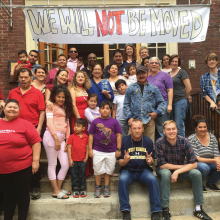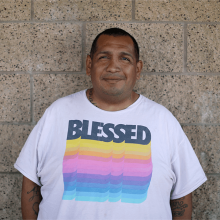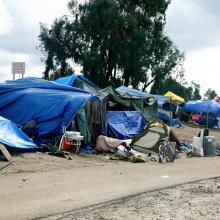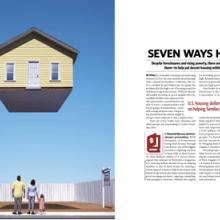affordable housing
Living Room Theology
Hosted by theologian Grace Ji-Sun Kim, the Madang podcast features erudite conversations with scholars, ministers, activists, and more. Named after the courtyards found in traditional Korean homes, the show provides an inviting, intimate space to envision a more just world. The Christian Century
FIDEL WAS FOUR years old when I met him in 2014. His family lived in an apartment building around the corner from us in Washington, D.C. He liked to fly around the apartment entryway with arms extended, making airplane sounds. He liked to say “no.” He played with toy cars during tenant organizing meetings.
Fourteen families shared the 26-unit building, which had decades of deferred maintenance. The absentee landlord (a Palm Beach-based Episcopalian, real estate magnate, and attorney, who preserves wealth for his children, practices elite philanthropy, and once served as protocol officer for Spiro “Bag Man” Agnew’s reelection campaign) had abandoned the building—except for rent extraction.
In Fidel’s one-bedroom apartment, he maneuvered around handfuls of roach motels and rodent snap traps. His mom sealed his clothing in airtight plastic bags to keep out the night-crawling, blood-sucking bed bugs. Upstairs, a neighbor slept with her “rat stick.” Water from the tap often ran brown or didn’t run at all. Stoves were rusted. Toilets leaked. Frigid winter air poured in through broken windows or damaged frames. Ceilings collapsed. Lead paint and mold flecked the baseboards where Fidel played and slept.
The tenants submitted repair requests. The building manager ignored them or responded inadequately. The sooner he could drive them out, the sooner the owner could flip the property to luxury condos and realize astronomical profit. One day, the owner notified tenants of a 31.5 percent rent increase. Failure to pay risked eviction. The owner’s preferential option for profit over people sent Fidel a clear message: You are disposable.
Quick and efficient though they may be, these emergency shelters are a short-term fix. With affordable housing scarce and real estate continuing to rise in one of California’s priciest markets, some critics are concerned Orange County is content to shunt the unhoused out of view without promoting permanent housing.
Churches across the nation are recognizing the value of their land how it can be leveraged to address the scarcity of affordable housing. An interfaith alliance in Colorado, which found faith organizations own more than 5,000 acres in the Denver metro area, communicated with 20 churches interested in transforming their unused land into housing. According to project reports from several church networks and partnered developers in northern Virginia, Washington, D.C. and Baltimore, more than 5,000 affordable housing units have been built, preserved or are being aided by church organizing in the area.
Airbnb — the company that ushered home-sharing into the mainstream — is facing backlash for exacerbating the affordable housing crisis in cities across the U.S. By booking weekend getaways through Airbnb and other home-sharing sites, travelers may be unknowingly and inadvertently worsening the crisis and supporting an industry that deprives locals of much needed long-term housing options.
Pricing Carbon Fuels
Thank you for your fine article on climate change (“Shattering the Silence on Climate Change” by Teresa Myers, Connie Roser-Renouf, and Edward Maibach, May 2017). There is no larger long-term challenge facing humankind. The mention of Citizen’s Climate Lobby deserves expansion. This grassroots, nonpartisan, national group has a very workable, market-friendly proposal to help us move forward: enacting a steadily rising federal fee on all carbon-based fuels (coal, oil, and natural gas). The net revenues from this fee would be returned on an equal per capita basis to all legal U.S. residents. Such a fee would correct a failure of the market to properly price the environmental and social costs associated with use of these resources. It would have a positive impact on economic growth, would favor a transition to nonpolluting energy resources, and would be fair to low-income residents.
Kenneth Piers
Grand Rapids, Michigan
The Pride of Milwaukee
One of the names in Lisa Sharon Harper’s “Find the Cost of Freedom” (May 2017) was instantly familiar to me: James Cameron, the only young man “spared” from lynching, by imprisonment. I only wish Harper could have gone further in highlighting Cameron’s life. Having lived most of my life in the Milwaukee metro area, I have heard so much about Cameron—an extremely studious man and founder of the Black Holocaust Museum, a one-of-a-kind exhibition. Cameron was an exemplary man. He should be much more well-known than he is, and for much more than that he escaped a lynching. He was (and still is, as his heritage lives on) a very important man for Milwaukee residents.
Lynne Gonzales
Pewaukee, Wisconsin
Heartless Housing Policy
I was very happy to read the recent article “Raise Your Hand if You Live in Subsidized Housing,” by Neeraj Mehta (June 2017). It helps to uncover how we “allocate resources to people we value” and shows the inequality of how we subsidize housing in America. From my work with Hearts for Homes in Macomb County, Mich., it is clear to me that negative biases and stereotypes of low-income renters justify inaction on the part of policy makers and middle-class Americans. With the numbers of homeless children on the rise, at a time when employment is the highest since 2001, we still easily blame the poor as “not being responsible” or “having bad spending habits.” However, we seem unable to acknowledge or take responsibility for a housing system that requires many families to pay more than half of their income in housing expenses, putting many at risk of homelessness.
Richard Cannon
Mt. Clemens, Michigan
Cone’s Cross
Reading Danny Duncan Collum’s piece on Reinhold Niebuhr (“The Niebuhr We Need,” April 2017) and viewing the new documentary by Martin Doblmeier sent me back to my own review of America’s cold war theologian (“Apologist of Power,” March 1987). I write to commend James Cone’s chapter on Niebuhr in The Cross and the Lynching Tree (Orbis, 2011). Cone argues that Niebuhr’s theology of the cross was so abstract that it never occurred to him to recognize the most obvious representation of the former in the latter. Though still faculty at Union Seminary, Cone was not interviewed for the film.
Bill Wylie-Kellermann
Detroit, Michigan
Your response here. Write to letters@sojo.net or Letters, Sojourners, 408 C Street NE, Washington, DC 20002. In-clude your name, city, and state. Letters may be edited.
San Antonio is about 63 percent Hispanic — the largest majority-Hispanic city in America — 30 percent white and 7 percent black. Helmke suggested the interfaith group ought to look more like the population itself.
On Oct. 21, that same intentional Berkeley housing encampment — which has peacefully existed in its current location for the last nine months, was served a 72-hour eviction notice by the Bay Area Rapid Transit (BART) police by request from the City of Berkeley. Despite receiving over 3 million dollars in grants to expand housing, the City of Berkeley invests more of its time and resources displacing marginalized communities.
I remember the first day of my housing-policy class in graduate school. I was late. I had just left the Minneapolis Public Housing Authority where I was helping a family activate the housing-choice voucher they had recently been granted.
I found a seat near the door in the back of the classroom. After welcoming us, the professor opened with what seemed like a simple request: “Raise your hand if you have ever lived in subsidized housing.” In a class of about 40 students, only three or four hands went up. I kept mine down.
He followed with a second question: “How many of you have lived in a house either you or your parents owned?” I raised my hand—along with a majority of my classmates. “Congratulations,” he responded. “You too have lived in subsidized housing.”
He used the rest of class to describe the two major types of housing assistance offered by the U.S. government.
The first type is public housing and housing-choice vouchers that limit what a household pays for rent to 30 percent of their income. This is what most of us think of when we hear the phrase “subsidized housing.” The Department of Housing and Urban Development runs these programs, which are meant to benefit mainly households that earn 30 percent or less of median income for an area. This might be $12,750 for a family of four in Mississippi or $27,600 in California. Congress allots about $38 billion per year for these programs.
The second form of government-funded financial assistance for housing is the mortgage-interest tax deduction, which allows homeowners who itemize deductions to deduct the interest they pay on their home loans. The deduction can be applied to both primary and second residences, including boats with bathrooms. Most households that benefit from the mortgage-interest tax deduction earn between $100,000 and $500,000 a year. This, the largest housing subsidy program in the country, costs the federal government upward of $100 billion a year.
1. A Call for a National Lament
"Lament … is not a passive act. Many Christians may hear the word lament and assume that feeling bad about suffering is the purpose of lament. How sad that people died. How sad that the shooter had a mental illness. But lament moves beyond bad feelings for the privileged. ... Lament voices the prayers of the suffering and therefore serves as an act of protest against the powers."
2. Recalling Nine Spiritual Mentors, Gunned Down During Night of Devotion
“The nine victims — three men and six women, who ranged in age from 26 to 87 — were leaders, motivators, counselors and the people everyone could turn to for a heap of prayer, friends and relatives said.”
3. WATCH: Jon Stewart on Charleston Shooting
“This one is black and white. There’s no nuance here. … Nine people were shot in a black church by a white guy who hated them who wanted to start some kind of civil war. The confederate flag flies over South Carolina, and the roads are named for confederate generals. And the white guy feels like he’s the one who’s feels like this country has been taken away from him.”
4. WATCH: Changing the World Through Faith & Justice
Sojourners is hosting The Summit this week, and the conversations have been powerful. To catch all of today’s sessions, WATCH the livestream throughout the day and follow along on social media using #summitforchange. You can also view recorded sessions from the past two days. *Recordings available for a limited time.
1. Masculinity Gets Modern Makeover in Latest Getty Images Collection
Tired of seeing stock images that reinforce traditional gender roles? Getty Images is (finally) changing that with the help of Sheryl Sandberg's LeanIn.org.
2. The Human Right to Have a Home
As Congress plans to slash funding for housing assistance programs, Catholic bishops in the U.S. are protesting, arguing "housing is a human right."
3. WATCH: ‘What Are You?’ — Multiracial in America
Listen to how multiracial Americans react when they're asked "What are you?" (Hint: I's usually not well).
REV. SUSAN QUINN BRYAN walked into a meeting of the Friends of the Anna Louise Inn fully prepared for a room brimming with people. Instead, Bryan and the five other Presbyterian pastors she had brought with her doubled the meeting’s total attendance. Bryan was stupefied.
When she moved to Cincinnati in 2005 to pastor Mount Auburn Presbyterian Church, several of her congregants had taken her to the Anna Louise Inn, claiming it as one of the things they loved most about the city. And yet, in its time of need, hardly anyone had come to the Inn’s rescue. It would take several minutes before an even more startling realization came to Bryan.
“As [people] began talking, I thought, ‘Where’s the church? How can the church stand silent while this is happening?’” she said. “So I organized a breakfast and just sent out emails to all the clergy I could find.”
About 25 Cincinnati faith leaders came to Bryan’s breakfast, and out of it emerged an ecumenical force, crossing denominational divides to rally behind one of Cincinnati’s most revered institutions.
THE BATTLE FOR the Anna Louise Inn began in 2007 after Cincinnati Union Bethel (CUB), the social service agency that operates the Inn, decided the Inn needed updated facilities.
Despite foreclosures and rising poverty, there are models -- lots of them -- to help put decent housing within reach.
For those who came to the Justice Revival's free opening night program (featuring former United Methodist District Superintendent and Texas State House Rep. Dr.









